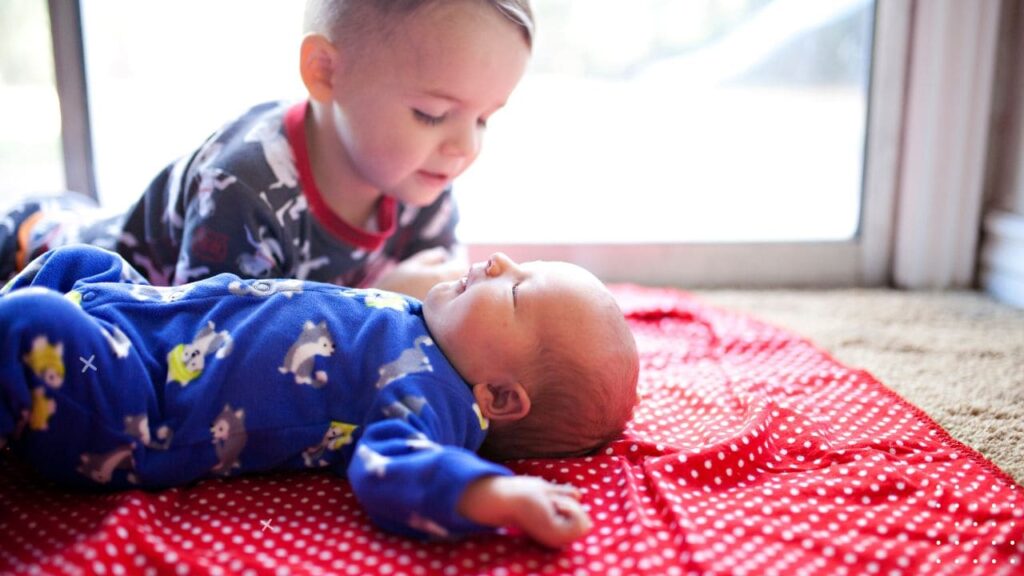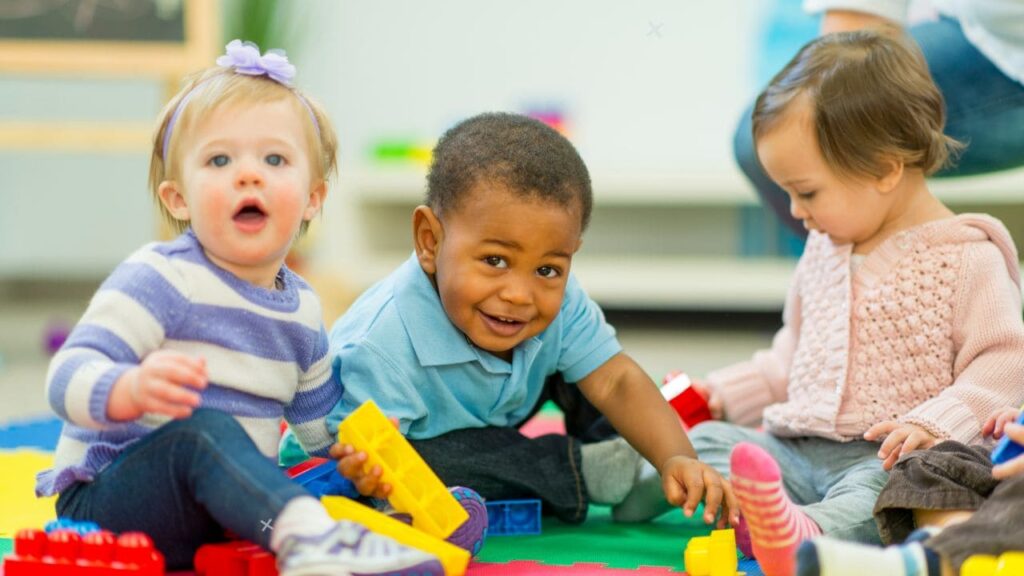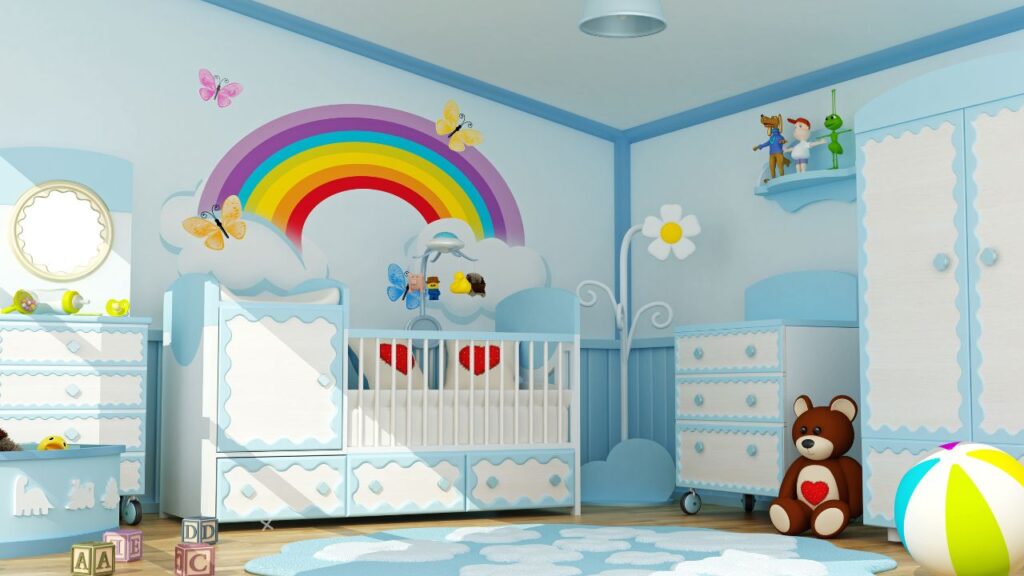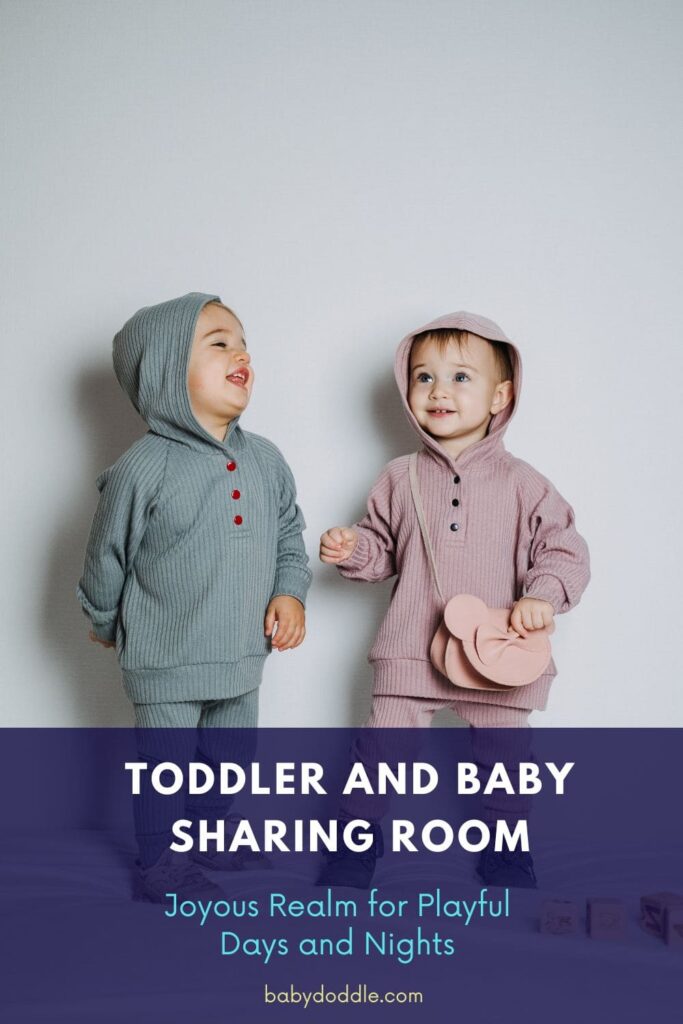As the newest additions to your family, your toddler, and baby fill your home with boundless energy, giggles, and precious moments. While the journey of raising two little ones can be demanding, creating a shared space for them can foster an unbreakable bond and a lifetime of cherished memories. Imagine a room where their laughter echoes, their creativity blossoms, and their sibling connection deepens with each passing day. Welcome to the joyous realm of the toddler and baby sharing room – a harmonious haven where playful days and nights unfold.

The Magic of Sibling Bonding
From the moment your baby locks eyes with their older sibling, a special connection begins to form. Sharing a room allows this bond to flourish organically, as they learn to navigate the world together, share experiences, and create lasting memories. This close proximity encourages empathy, patience, and a deep sense of camaraderie that will serve them well throughout their lives.
Moreover, a shared room fosters an environment where your toddler can learn valuable life lessons. By witnessing the care and attention you provide for their younger sibling, they develop a sense of responsibility and nurturing instincts. As they observe their baby brother or sister’s milestones, they gain an appreciation for the wonders of growth and development.
Cost-Effective Harmony
Let’s face it – raising children can be a financial juggling act. By having your toddler and baby share a room, you not only create a cozy, intimate space for them but also make the most of the available square footage in your home. This cost-effective approach allows you to allocate resources towards other essential needs, without compromising on creating a warm and inviting space for your little ones.
Fostering Lifelong Connections
The sibling bond formed in a shared room can have profound and lasting impacts on your children’s lives. Sharing experiences, secrets, and even squabbles from an early age can lay the foundation for a deep, unbreakable connection that transcends childhood.
As they grow older, this bond can serve as a source of support, comfort, and companionship, helping them navigate the ups and downs of life. Siblings who share a room often develop a unique understanding and appreciation for each other’s quirks, strengths, and vulnerabilities, fostering a level of trust and loyalty that is difficult to replicate elsewhere.
Furthermore, the shared memories and inside jokes created within the confines of their shared space can become cherished traditions that they carry with them into adulthood, serving as a constant reminder of the unbreakable ties that bind them together.
When to Embark on Room Sharing
The ideal time to introduce room sharing can vary depending on your family’s circumstances and your children’s individual temperaments. However, many experts recommend waiting until your baby is at least 6 months old before transitioning them into the same room as your toddler.
During the first few months, newborns require frequent night feedings and often wake up multiple times throughout the night. Sharing a room too early could disrupt your toddler’s sleep patterns, leading to crankiness and fatigue. By waiting until your baby’s sleep cycles become more predictable, you can establish a smoother transition and minimize disruptions for both children.
Next Step: Consult with your pediatrician or child development specialist to determine the optimal time for your family to begin room sharing, taking into account your children’s ages, sleep habits, and individual needs.
Respecting Individual Temperaments
Every child is unique, and their temperaments can play a significant role in determining the ideal time for room sharing. While some toddlers may embrace the idea of having a roommate with open arms, others may initially struggle with the change and need more time to adjust.
If your toddler is particularly sensitive to noise or disruptions, or if they have difficulty transitioning between sleep cycles, it may be beneficial to delay room sharing until they are a little older and more adaptable. Conversely, if your toddler is easygoing and adapts well to new situations, you may be able to introduce room sharing earlier.
Similarly, consider your baby’s temperament and sleep patterns. Some infants are naturally sound sleepers, while others are more easily disturbed by external stimuli. By observing your children’s individual quirks and tendencies, you can make an informed decision about the optimal time to begin room sharing, minimizing potential disruptions and ensuring a smoother transition for all.

Room Planning: A Balancing Act
Designing a shared space that caters to the needs of both your toddler and baby requires careful planning and organization. Start by maximizing the available space and creating distinct zones for sleeping, playing, and storage.
Place your toddler’s bed and your baby’s crib on opposite sides of the room, allowing each child to have their own designated sleep area. This separation can help minimize disturbances and ensure that your baby’s movements or noises don’t constantly wake your toddler, and vice versa.
Next, establish a dedicated play area that encourages age-appropriate activities and fosters their development. For your toddler, incorporate toys that stimulate imaginative play, problem-solving skills, and motor coordination. For your baby, provide safe, interactive toys that promote sensory exploration and cognitive growth.
Don’t forget to include comfortable seating options, such as a cozy reading nook or a plush play mat, where you can engage with your children during playtime. Strategically placed storage solutions, like shelves, baskets, and toy chests, will help keep the room organized and clutter-free.
Childproofing: A Sanctuary of Safety
Safety should be paramount when creating a shared space for your toddler and baby. Start by securing all furniture to the walls, ensuring that dressers, bookshelves, and cribs are stable and won’t topple over. Remove any potential choking hazards, such as small toys or loose objects, and install safety gates to prevent wandering little ones from accessing off-limits areas.
Consider investing in monitoring devices, like baby monitors or motion sensors, to keep a watchful eye on your children even when you’re not in the room. Additionally, implement effective noise and light control measures, such as blackout curtains or white noise machines, to create a soothing sleep environment for both your toddler and baby.
Sleep Sanctuary: Peaceful Nights, Energetic Days
A good night’s sleep is crucial for your children’s growth, development, and overall well-being. When designing their shared room, prioritize creating a tranquil sleep environment that promotes restful slumbers.
Choose age-appropriate bedding and mattresses that provide comfort and support. For your baby, opt for a firm, breathable mattress and fitted sheets to reduce the risk of suffocation. For your toddler, consider a cozy but supportive mattress that can accommodate their growing body.
Establish consistent bedtime routines that signal to your children that it’s time to wind down. This could include bath time, reading a bedtime story, or singing lullabies. Consistently following these routines will help your toddler and baby associate certain activities with sleep, making it easier for them to settle down for the night.
Next Step: Experiment with different bedtime routines and sleep environments to find what works best for your family. Be patient and persistent, as it may take some time for your children to adjust to their new sleep arrangements.
Versatile Storage Solutions
Effective storage is key to maintaining an organized and clutter-free shared space. Consider investing in versatile and modular storage solutions that can adapt to your children’s evolving needs.
Wall-mounted shelves or cubbies can provide easy access to books, toys, and other essentials while keeping them off the floor and out of the way. Opt for adjustable shelving units that can grow with your children, allowing you to rearrange and reconfigure the storage as needed.
Baskets and bins are another great option for corralling smaller items and encouraging your children to tidy up after themselves. Label them clearly with words or pictures to help your toddler understand where different toys or belongings should be stored.
For larger items, consider investing in a dresser or armoire that can serve multiple purposes. Not only can it provide ample storage for clothing and linens, but it can also double as a changing station or display area for treasured keepsakes.
Stimulating Play Zones
A well-designed play area can foster your children’s cognitive, physical, and social-emotional development while encouraging their natural curiosity and creativity. Incorporate age-appropriate toys and activities that cater to their specific interests and stages of development.
For your toddler, consider building blocks, puzzles, art supplies, and pretend play sets that stimulate their imagination and problem-solving abilities. Encourage them to explore different textures, colors, and shapes, as these sensory experiences aid in their cognitive growth.
For your baby, provide safe, interactive toys that promote sensory exploration, such as rattles, textured balls, and activity mats. As they grow, introduce toys that encourage fine motor skills, like stacking rings or shape sorters.
Remember to rotate toys regularly to keep the play area fresh and engaging, and involve your children in the process of choosing and organizing their toys. This not only keeps them interested but also teaches them valuable organizational skills.
| Age | Toddler Toys | Baby Toys |
|---|---|---|
| 12-18 months | Stacking rings/cups, Shape sorters, Push/pull toys | Soft blocks, Rattles, Board books |
| 18-24 months | Sorting toys, Pretend play sets, Drawing/painting supplies | Ball droppers, Musical instruments, Nesting toys |
| 2-3 years | Puzzles (12-24 pieces), Building blocks, Play dough | Stacking toys, Pop-up toys, Bath toys |
| 3-4 years | Dress-up clothes, Art and craft supplies, Simple board games | Shape puzzles, Push/pull toys, Sorting toys |

Nurturing Individuality
While sharing a room can foster a strong sibling bond, it’s equally important to nurture each child’s individuality and sense of self. Incorporate personalized touches that reflect their unique interests, personalities, and preferences.
Dedicate a small corner or wall space for displaying their artwork, photographs, or special mementos. Encourage them to decorate their individual spaces with their favorite colors, characters, or themes. This not only fosters self-expression but also creates a sense of belonging and ownership within the shared space.
Next Step: Involve your toddler in the decorating process by allowing them to choose colors, bedding, or wall decals for their area. This simple act can boost their confidence and make them feel valued and respected.
Managing Sibling Dynamics
While sharing a room can strengthen the sibling bond, it’s natural for conflicts and disagreements to arise occasionally. Establish clear boundaries and rules from the outset to promote harmonious coexistence.
Set guidelines for respecting each other’s personal space and belongings, as well as expectations for behavior during playtime and bedtime. Involve your toddler in the process of creating these rules, as they are more likely to adhere to them if they have a sense of ownership.
Encourage positive interactions and sharing by modeling these behaviors yourself. Praise and reinforce instances when your children engage in cooperative play or demonstrate acts of kindness towards one another.
When conflicts arise, stay calm and guide your children through the problem-solving process. Teach them effective communication strategies, such as using “I” statements and actively listening to each other’s perspectives. This not only diffuses tense situations but also equips them with valuable life skills.
| Strategy | Description |
|---|---|
| Calm Intervention | Separate the children and allow them to cool down before discussing the issue. |
| Active Listening | Encourage each child to express their feelings and perspective without interruption. |
| Identify the Problem | Help them pinpoint the root cause of the conflict and validate their emotions. |
| Brainstorm Solutions | Guide them in exploring possible solutions and compromises. |
| Reinforce Positive Behavior | Praise and reward instances of sharing, empathy, and conflict resolution. |
| Consistency | Ensure that both parents |
Room Organization and Maintenance
A well-organized and tidy room can contribute to a sense of calm and tranquility, making it easier for your children to focus and engage in productive play. Develop a system for decluttering and rotating toys, ensuring that the space remains clutter-free and visually appealing.
Involve your toddler in the process of organizing and maintaining their shared space. Assign age-appropriate chores, such as putting away toys or making their bed, to instill a sense of responsibility and ownership. Provide ample storage solutions, such as shelves, baskets, or toy chests, to keep shared and individual items neatly organized.
Next Step: Create a visual organizational system, such as labeled bins or shelves, to help your toddler easily identify where toys and belongings belong. This not only promotes independence but also teaches valuable sorting and categorization skills.
Embracing Growth and Change
As your children grow and their needs evolve, be prepared to adapt their shared space accordingly. Invest in flexible furniture and modular designs that can be easily reconfigured or expanded as necessary.
Consider the possibility of eventually separating your toddler and baby into individual rooms, especially as they approach the tween and teenage years when privacy and personal space become increasingly important. Plan for potential room separations or expansions by keeping an eye out for suitable living arrangements or home renovations.
Throughout these transitions, maintain open communication with your children. Involve them in the decision-making process and listen to their perspectives and preferences. This not only fosters a sense of trust and respect but also prepares them for future changes and challenges they may encounter in life.
Parental Rejuvenation
While creating a harmonious shared space for your toddler and baby is crucial, it’s equally important to prioritize your own well-being as parents. Ensure that your sleep needs are met by establishing a consistent sleep routine for your children that aligns with your own rest requirements.
Consider investing in noise-canceling headphones or earplugs to minimize disruptions during the night, or take turns with your partner in attending to your children’s needs. Additionally, carve out dedicated “me time” for self-care activities, such as reading, exercising, or simply taking a relaxing bath.
Remember, a well-rested and rejuvenated parent is better equipped to provide the nurturing care and guidance that your toddler and baby need to thrive in their shared space.
Preparing Your Toddler
The transition to room sharing can be a significant adjustment for your toddler, who may initially feel apprehensive or resistant to the change. To help them embrace this new chapter, involve them in the process from the very beginning.
Talk it up: Excite your toddler about the prospect of sharing a room with their new sibling. Frame it as a special milestone and a chance for them to be a “big kid.” Read books or watch age-appropriate shows that depict positive sibling relationships to reinforce the idea of sharing a space.
Give them a say: Allow your toddler to have a voice in the room’s decor choices, such as picking out their bedding, wall colors, or artwork. This simple act can make them feel valued and invested in their new shared space.
Set clear expectations: Explain the “ground rules” for sharing a room in a calm and age-appropriate manner. Emphasize the importance of respecting each other’s space and belongings, as well as being mindful of noise levels during sleep times.
Turn it into a teaching moment: Use this transition as an opportunity to impart valuable lessons in empathy, patience, and conflict resolution. Celebrate instances when your toddler demonstrates these qualities, and gently guide them when they struggle.
By involving your toddler in the process and fostering a sense of excitement and ownership, you can help make the transition to room sharing a positive and memorable experience for your entire family.
Conclusion:
Creating a shared space for your toddler and baby is more than just a practical solution; it’s an opportunity to nurture a lifelong bond, instill valuable life lessons, and create cherished memories. By carefully designing a safe, stimulating, and nurturing environment, you can transform their shared room into a joyous realm where playful days and peaceful nights unfold.
Embrace the challenges and celebrate the triumphs that come with this unique journey. Remember, every giggle, every milestone, and every sibling moment shared within these walls will become the foundation of a strong, unbreakable connection that will carry them through their lives.
So, let the laughter echo, the imaginations soar, and the sibling bond flourish in this special space you’ve created – a true testament to the love and joy that define your family.
FAQ – Toddler and Baby Sharing Room
When is the best time to have a toddler and baby start sharing a room?
The ideal time to transition a toddler and baby into sharing a room can vary, but many experts recommend waiting until the baby is around 6 months old. By this age, the baby’s sleep patterns tend to be more predictable, reducing the risk of frequent night wakings disrupting the toddler’s sleep. It’s also important to consider each child’s temperament and sleep habits, as some may adapt to room sharing more easily than others.
How can I prepare my toddler for the transition to sharing a room?
Involve your toddler in the process from the beginning. Talk up the idea of becoming a “big kid” and sharing a room with their sibling. Allow them to have a say in decorating choices and explain the “ground rules” for respecting each other’s space and belongings. Read books or watch shows that depict positive sibling relationships to help them understand the benefits of sharing a room. With patience and encouragement, you can turn this transition into an exciting milestone for your toddler.
What are some tips for creating a safe and functional shared space?
Safety should be the top priority. Secure all furniture to the walls, eliminate potential choking hazards, and install safety gates and monitoring devices. Separate sleep areas by placing the toddler’s bed and baby’s crib on opposite sides of the room to minimize disturbances. Designate distinct play zones for different age groups and incorporate age-appropriate toys and activities. Implement effective noise and light control measures, such as blackout curtains or white noise machines, to create a soothing sleep environment.
How can I encourage positive sibling interactions in a shared room?
Set clear boundaries and rules for respecting each other’s personal space and belongings. Model and reinforce positive behaviors, such as sharing, empathy, and conflict resolution. Praise instances of cooperative play and guide them through problem-solving when conflicts arise. Create opportunities for collaborative play by setting up shared play stations or introducing activities that require teamwork and communication.
What should I do if my children have difficulty adjusting to room sharing?
Remain patient and consistent with routines and rules. Provide individual attention and validate each child’s feelings. Identify and address the root causes of any challenges, such as noise or sleep disruptions. Consider adjusting the room layout or implementing additional noise-reduction strategies. If necessary, seek advice from a pediatrician, child development specialist, or family therapist for personalized guidance.












